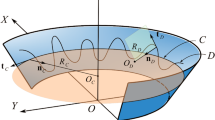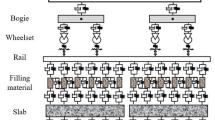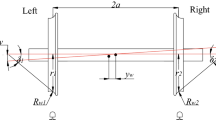Abstract
The geometry description plays a central role in many engineering applications and directly influences the quality of the computer simulation results. The geometry of a space curve can be completely defined in terms of two parameters: the horizontal and vertical curvatures, or equivalently, the curve curvature and torsion. In this paper, distinction is made between the track angle and space-curve bank angle, referred to in this paper as the Frenet bank angle. In railroad vehicle systems, the track bank angle measures the track super-elevation required to define a balance speed and achieve a safe vehicle operation. The formulation of the track space-curve differential equations in terms of Euler angles, however, shows the dependence of the Frenet bank angle on two independent parameters, often used as inputs in the definition of the track geometry. This paper develops the general differential equations that govern the track geometry using the Euler angle sequence adopted in practice. It is shown by an example that a curve can be twisted and vertically elevated but not super-elevated while maintaining a constant vertical-development angle. The continuity conditions at the track segment transitions are also examined. As discussed in the paper, imposing curvature continuity does not ensure continuity of the tangent vectors at the curve/spiral intersection. Several curve geometries that include planar and helix curves are used to explain some of the fundamental issues addressed in this study.








Similar content being viewed by others
References
Pascal, J.P., Sany, J.R.: Dynamics of an isolated railway wheelset with conformal wheel–rail interactions. Veh. Syst. Dyn. 54, 1947–1969 (2019)
Zhang, Y., El-Sibaie, M., Lee, S.: FRA track quality indices and distribution characteristics. In: AREMA 2004 Annual Conference, Nashville, TN, USA (2004)
Andersson, C., Abrahamsson, T.: Simulation of interaction between a train in general motion and a track. Veh. System Dyn. 38, 433–455 (2002)
True, H.: Does a critical speed for railroad vehicles exist? In: Proceedings of IEEE/ASME Joint Railroad Conference, pp. 125–131 (1994)
Berghuvud, A.: Freight car curving performance in braked conditions. IMechE J. Rail Rapid Transit 216, 23–29 (2002)
Boocock, D.: The steady-state motion of railway vehicles on curved track. J. Mech. Eng. Sci. 2 (1969)
De Pater, A.D.: The geometrical contact between track and wheel-set. Veh. Syst. Dyn. 17, 127–140 (1988)
Elkins, J.A., Gostling, R.J.: A general quasi-static curving theory for railway vehicles. In: Proceedings of 2nd IUTAM Symposium, Vienna, pp. 388–406 (1977)
Endlicher, K.O., Lugner, P.: Computer simulation of the dynamical curving behavior of a railway bogie. Veh. Syst. Dyn. 19, 71–95 (1990)
Gilchrist, A.O.: The long road to solution of the railway hunting and curving problems. IMechE J. Rail Rapid Transit 212, 219–226 (1998)
Grassie, S.L.: Dynamic modeling of the track. In: Kalker, J.J., Cannon, D., Orringer, O. (eds.) Rail quality and maintenance for modern railway operation. Kluwer, Dordrecht (1993)
Hamid, A., Rasmussen, K., Baluja, M., Yang, T-L.: Analytical description of track geometry variations. FRA report no. DOT/FRA/ORD-83/03.1 (1983)
Handoko, Y., Xia, F., Dhanasekar, M.: Effect of asymmetric brake shoe force application on wagon curving performance. Veh. Syst. Dyn. Suppl. 41, 113–122 (2004)
Kerr, A.D., El-Sibaie, M.A.: On the new equations for the lateral dynamics of rail-tie structure. ASME J. Dyn. Syst. Meas. Control 107, 180–185 (1987)
Kik, W.: Comparison of the behavior of different wheelset-track models. Veh. Syst. Dyn. 20, 325–339 (1992)
Knothe, K.L., Grassie, S.L.: Modeling of railway track and vehicle/track interaction at high frequencies. Veh. Syst. Dyn. 22, 209–262 (1993)
Knothe, K., Stichel, S.: Direct covariance analysis for the calculation of creepages and creep-forces for various bogie on straight track with random irregularities. Veh. Syst. Dyn. 23, 237–251 (1994)
Shabana, A.A., 2021, Mathematical Foundation of Railroad Vehicle Systems, Wiley & Sons (in press)
Shabana, A.A., Zaazaa, K.E., Sugiyama, H.: Railroad Vehicle Dynamics: A Computational Approach. CRC Press, Boca Raton (2008)
Wickens, A.: Fundamentals of Rail Vehicle Dynamics. CRC Press, Boca Raton (2005)
Rathod, C., Shabana, A.A.: Geometry and differentiability requirements in multibody railroad vehicle dynamic formulations. Nonlinear Dyn. 47(1–3), 249–261 (2007)
Shabana, A.A., Ling, H.: Noncommutativity of finite rotations and definitions of curvature and torsion. ASME J. Comput. Nonlinear Dyn. 14(9) (2019)
Kreyszig, E.: Differential Geometry. Dover Publications, New York (1991)
Do Carmo, M.P.: Differential Geometry of Curves and Surfaces. Prentice Hall, Englewood Cliffs (1976)
Klauder Jr., L.T., Chrismer, S.M., Elkins, J.: Improved spiral geometry for high-speed rail and predicted vehicle response. Transp. Res. Rec. 1785(1), 41–49 (2002)
Levent, A., Sahin, B., Habib, Z.: Spiral Transitions. Appl. Math. J. Chin. Univ. 33, 468–490 (2018)
Hedrick, J.K., Arslan, A.V.: Nonlinear analysis of rail vehicle forced lateral response and stability. ASME J. Dyn. Syst. Meas. Control 101, 230–237 (1979)
Jeambey, J.: Improving high speed stability of freight cars with hydraulic dampers. In: Proceedings of the 1998 ASME International Mechanical Engineering Congress & Exposition (Rail Transportation), Anaheim, California (1998)
Matsumoto, A., Sato, A., Ohno, Y., Suda, H., Nishimura, Y., Tanimoto, R., Oka, M.: Compatibility of curving performance and hunting stability of railway bogie. Veh. Syst. Dyn. Suppl. 33, 740–748 (1999)
Shabana, A.A.: Computational Continuum Mechanics, 3rd edn. Wiley, London (2018)
Johnson, K.L.: Contact Mechanics. Cambridge University Press, Cambridge (1985)
Kalker, J.J.: Three-Dimensional Elastic Bodies in Rolling Contact. Kluwer, Dordrecht (1990)
Klauder, L.T.: Railroad spiral design and performance. In: Proceedings of the 2012 Joint Rail Conference, American Society of Mechanical Engineers Digital Collection, pp. 9–21 (2012)
Acknowledgements
This research was supported by the National Science Foundation (Project # 1632302).
Author information
Authors and Affiliations
Corresponding author
Additional information
Publisher's Note
Springer Nature remains neutral with regard to jurisdictional claims in published maps and institutional affiliations.
Appendix
Appendix
1.1 Fresnel integrals
The Fresnel integrals S(x) and C(x) are defined by following power-series expansions which converge for all values of the argument x:
The trace of the parametric plot of Fresnel integrals \( \left[ {C(x),S(x)} \right] \) is called an Euler spiral or a clothoid, whose curvature at any point is proportional to the distance from the origin.
Rights and permissions
About this article
Cite this article
Ling, H., Shabana, A.A. Euler angles and numerical representation of the railroad track geometry. Acta Mech 232, 3121–3139 (2021). https://doi.org/10.1007/s00707-020-02903-4
Received:
Revised:
Accepted:
Published:
Issue Date:
DOI: https://doi.org/10.1007/s00707-020-02903-4




